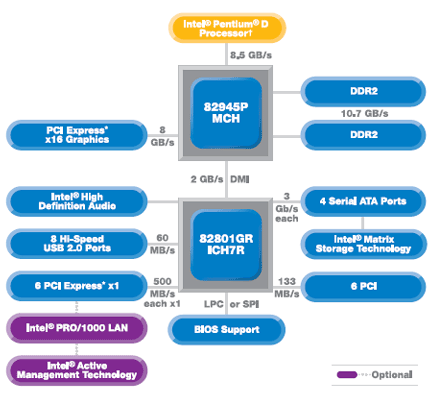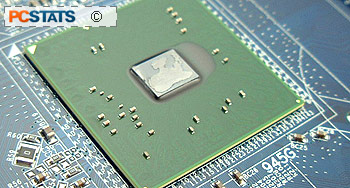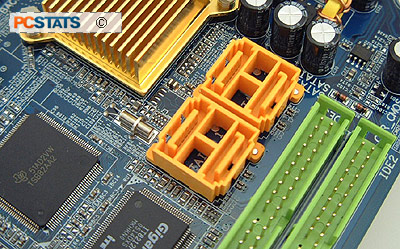In the spring of 2005, Intel released its two newest
desktop chipsets, the 945P/G and 955X Express. The 945 is the more mainstream of
the two chipsets, coming in two variations: the 'G' version which incorporates
Intels' GMA 950 integrated graphics solution, and the 'P' version which does not. The 955X Express
is the new version of Intel's previous high-end desktop performance chipset, the 925X
and represents the more 'enthusiast' friendly option. Let's have take a
closer look at that 945P chipset, as this is what the GA-8I945P Pro motherboard
is built upon.

The most
obvious reason for the 945P chipset's existence is to support Intel's new dual-core Pentium D
processor. Unlike AMD, Intel apparently needed to make provisions beyond BIOS updates in order
to work with these new dual CPUs, so support was delayed
until the release of the 945P and the higher-end 955X Express chipsets.
The 945P does add more than just dual-core flavours though. The Serial ATA II
standard was previously only available for Intel-based systems through nVidia's nForce 4 Intel
Edition chipsets, but the Intel 945P brings this high-speed hard disk
transfer standard back onside.
 The 945P chipset supports only DDR II
memory, and can handle up to 4GB of it. CPU FSB's supported include the
popular 533MHz to 1066MHz processor variants. PCI Express x16 is
the video connector of choice; Intel currently supports only a single x16 slot for one graphics
card, but rumors are that 945P may eventually gain SLI or ATI CrossFire support along
with its 955X Express big brother, or even an Intel-only dual-videocard
solution. At the time of this writing, the details have not yet
been firmed up.
The 945P chipset supports only DDR II
memory, and can handle up to 4GB of it. CPU FSB's supported include the
popular 533MHz to 1066MHz processor variants. PCI Express x16 is
the video connector of choice; Intel currently supports only a single x16 slot for one graphics
card, but rumors are that 945P may eventually gain SLI or ATI CrossFire support along
with its 955X Express big brother, or even an Intel-only dual-videocard
solution. At the time of this writing, the details have not yet
been firmed up.
The Intel ICH-7R Southbridge controller includes ample
multimedia capabilities, and supplants the ICH6 chipset. The
ICH-7R only uses a single ATA-100 IDE controller (as Intel is trying to
phase out Parallel IDE in favour of SATA) but provides four SATA
II ports, an integrated Gigabit network adaptor and eight USB 2.0 ports. The 'R' means
RAID, and the ICH-7R also supports RAID modes 0,1 and 5. Native Command
Queuing is not supported by the ICH-7R's SATA controller as it is
in nVidia's Intel chipset.
In addition to the 16 lanes reserved for the videocard, an additional
two PCI Express lanes can be used for two PCIe x1 connectors, which is less
than the six additional lanes that the 955X Express chipset boasts, but
enough for current needs.
The 945P and ICH-7R chips are connected by
means of a 2GB/s Direct Media Interface link, just like the previous
generation 925X/ICH-6R Northbridge/Southbridge combination.
 Overall, the
945P chipset currently has the dual effect of pulling Intel even with nVidia in
terms of the features the companies can offer on the Intel processor platform
and providing a valid mainstream chipset for the Intel dual-core processors. The
Intel 925X and 915P chipsets looked distinctly low-tech next to the nVidia nForce
4 Intel Edition, so the features introduced by the 945P and 955X Express
chipsets were a necessary next step for Intel.
Overall, the
945P chipset currently has the dual effect of pulling Intel even with nVidia in
terms of the features the companies can offer on the Intel processor platform
and providing a valid mainstream chipset for the Intel dual-core processors. The
Intel 925X and 915P chipsets looked distinctly low-tech next to the nVidia nForce
4 Intel Edition, so the features introduced by the 945P and 955X Express
chipsets were a necessary next step for Intel.
Once the whole SLI/CrossFire/multiple PCI video card issue has become
clearer, these chipsets may prove to be a more flexible platform than their
closest competitors too.
The most important factor though, is that Intel
now has a mainstream chipset to support its dual-core CPUs. Now that the
company's dual-core processors have been released into the wild, Intel can get down to business trying to
win back sales from AMD. Since the prices of the Pentium D dual-core
chips are considerably lower than the AMD equivalent, this may happen faster
than AMD would like.
